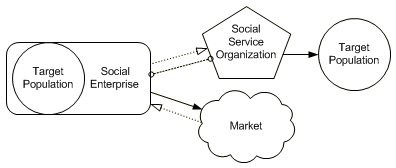Complex Model
Complex Model A complex model of social enterprise combines two or more operational models. Complex models are flexible; virtually any number or type of operational models can be combined into one social enterprise.
A complex model of social enterprise combines two or more operational models. Complex models are flexible; virtually any number or type of operational models can be combined into one social enterprise.
Models are combined to achieve desired impact and revenue objectives. For example, operational models that fall into integrated or external social enterprise categories may yield greater financial benefit, whereas embedded social enterprises offer higher social return, thus models are combined to achieve the dual objectives of the social enterprise. If appropriate for an organization's target population, the employment model is often combined with one of the other models to add social value--i.e. employment and organizational support model (as illustrated). Operational models are often combined as part of a natural diversification and growth strategy as the social enterprise matures.
Theoretical example: an African horticulture cooperative runs a social enterprise that links local growers to buyers in European markets. The services it provides to small producer clients include: horticulture technical assistance, quality control, contractual relations with flower importers and freight. This social enterprise earns income by charging European companies a commission on each sale, thereby covering the costs of its client services. After some years of operating their market linkage social enterprise, cooperative managers saw a lucrative opportunity to expand their business by entering the horticulture industry as a producer. To avoid competing with their clients, they choose to grow hybrid roses, a market whose infrastructure and costs bar small producers from entering. Hybrid roses are fickle, requiring constant care, which provided the cooperative an opportunity to create employment for a large number of low-income and unskilled people in the community. Profits from the rose business support the parent organization’s hard-to-fund operating costs, as well as funding the startup of a new social enterprise, a horticulture school. This example of a complex model combines: market linkage, organizational support and employment operating models.
Cambiando Vidas, an example of Complex Model
In 1999 a new paved highway opened along Mexico's formally isolated coastal fishing villages in Nayarit State to tourists, and consequently, to large developers. The result was a dramatic shift in the local economy from fishing and agriculture to tourism and infrastructure development. The shift displaced local residents, most of whom are poorly educated peasants and lack the know-how and capital to capture the changing market.
In response, Cambiando Vidas--"Changing Lives," an educational organization, launched a comprehensive, multifaceted rural development program with complementary enterprise and social service components to preserve the local community and provide new livelihoods for its residents.
Cambiando Vidas built a "tool lending library" where residents can borrow hand and power tools and use them as implements in economic activities tied to tourism and construction. The second social component is a vocational training program that teaches construction skills--masonry, electric, plumbing, and carpentry--to unemployed youth and adults in the community. The library supplies tools for the vocational training program.
On the enterprise side, Cambiando Vidas has initiated a B&B project and built (so far) six comfortable tourist rooms above residents' homes. Income from room rental is divided between owners as family income and a revolving loan fund to build more B&B rooms. Apprentices from the vocational training program provide the labor to build the B&Bs and gain work experience in the process.
Next, Cambiando Vidas will create local employment by launching a construction business and bidding directly on small building contracts, where it has identified a viable niche, as well as subcontracting to large developers. Profit from the construction business will be used to fund the secondary education and vocational training program.